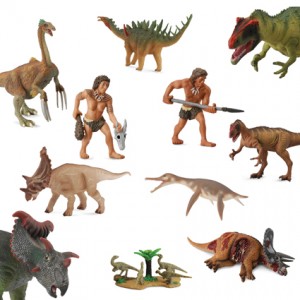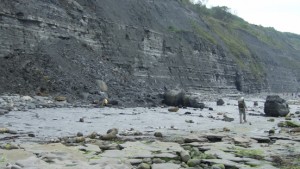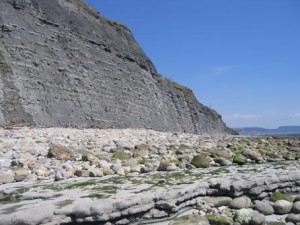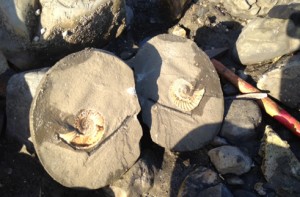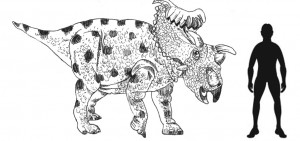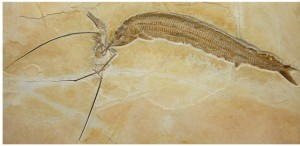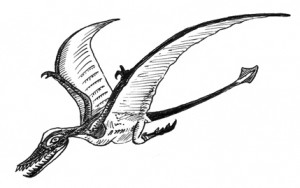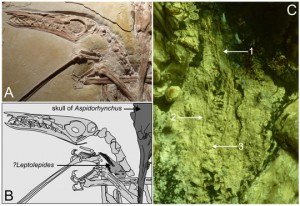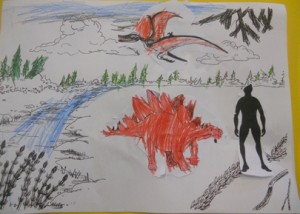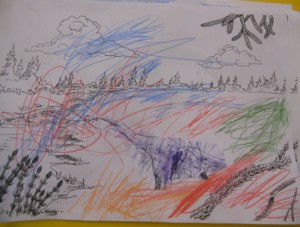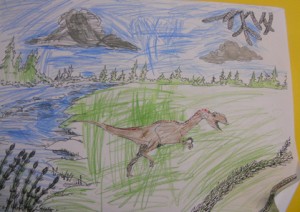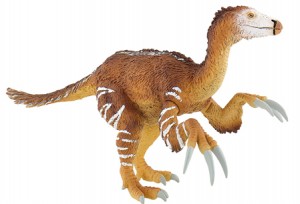Pterosaur Bone Found Lodged in Velociraptor Body Cavity Suggests a Scavenged Meal
Scientists have published a paper detailing their studies into a very well preserved skeleton of a Velociraptor (Velociraptor mongoliensis) which reveals evidence of one of the last meals of this little Cretaceous carnivore. The fossil was unearthed in the Gobi desert back in 1994, but a detailed, formal study has only just been completed and published in the scientific journal “Palaeogeography, Palaeoclimatology, and Palaeoecology”.
Last Meal of a Velociraptor
The fossil find, the first discovery of a pterosaur bone in the body cavity of a dinosaur, suggests that dromaeosaurs such as Velociraptor (V. mongoliensis), although active hunters, would have resorted to scavenging any available carcase that they could find.
An Illustration of Velociraptor mongoliensis
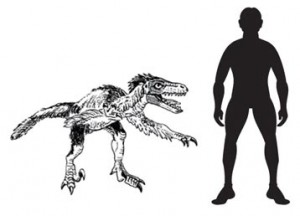
Did a juvenile Velociraptor have pterosaur as its last meal?
Picture credit: Everything Dinosaur
Velociraptor, made famous by its largely inaccurate portrayal in the Jurassic Park film trilogy, was a small, fast running, Late Cretaceous carnivore, perhaps as much as two metres long and standing a metre high. It had a long, narrow snout, with jaws that were capable of opening very wide. The jaws were lined with about eighty, small, sharp teeth. Velociraptor had long, three-clawed hands but perhaps its most famous anatomical feature was the enlarged, sickle-shaped claw on the second toe. Scientists remain unsure as to what this huge toe claw was used for. It has been suggested that this claw, that could be held clear of the ground as the animal walked, may have acted like a grappling hook, helping this predator latch onto and cling to struggling prey. Velociraptor mongoliensis is known from a number of superb fossil specimens including an amazing fossil of a Velociraptor preserved with a herbivorous Protoceratops apparently these dinosaurs perished whilst in combat.
The international research team included palaeontologists from University College (Dublin), the pterosaur bone inside the rib cage of the predator is an exciting discovery, this suggests that a flying reptile was one of the last things that this little dinosaur ate before it to met its demise. The fossils suggest that this Velociraptor was a sub-adult, not yet fully grown perhaps weighing around 13 kilogrammes. The bone fragment inside the body cavity, is highly pneumatised and the walls of the bone are very thin. This suggests pterosaur, and given the fact that azhdarchid pterosaur remains have been found in strata dated to the same geological time period in that part of the Gobi desert, the research team have postulated that the bone is from a member of the Azhdarchidae group of flying reptiles.
The Rib Cage and the Pterosaur Bone

The last meal of a Velociraptor.
Picture credit: David Hone et al 2012
The black arrows in the picture point to the pterosaur remains found in the upper part of the rib cage, whilst the white arrow highlights evidence of a broken rib – evidence of a severe trauma in this dinosaur’s life.
The researchers have concluded that although Velociraptor was a fearsome predator, it would not have taken on a healthy full-sized pterosaur, an animal with a wingspan more than the length of the Velociraptor’s entire body.
David Hone, one of the co-authors of the scientific paper, based at University College Dublin’s School of Biology and Environmental Sciences stated:
“It would be difficult and probably even dangerous for the small theropod dinosaur to target a pterosaur with a wingspan of two metres or more, unless the pterosaur was already ill or injured. So the pterosaur bone we’ve identified in the gut of the Velociraptor was most likely scavenged from a carcase rather than the result of a predatory kill.”
Velociraptor mongoliensis
A spokesperson from Everything Dinosaur commented:
“It is possible that this particular Velociraptor was part of a pack and given it’s sub-adult size, it may have been quite low in the pecking order. Just like packs of hunting dogs in Africa today, low status animals may have had to wait their turn before being allowed to feast on a kill. Perhaps the pterosaur had been attacked and killed by the pack and this individual had to be satisfied with a quickly gulped down bone as well as a few other scraps”.
Of course, such ideas can only be assertions, there is no evidence to suggest how the bone came to be in the body cavity of the Velociraptor, suffice to say it was ingested and using studies of the feeding behaviours of extant carnivores for comparison, it is likely that this Velociraptor was scavenging from the long, dead remains of a pterosaur.
To view articulated models of various dromaeosaurids: Beasts of the Mesozoic Articulated Dinosaurs.
A Close-Up of the Bone in the Rib Cage

The bone is highlighted in red
Picture credit: David Hone et al 2012 with additional annotation by Everything Dinosaur.
In the enlargement above we have highlighted the pterosaur bone in red, the scale bar provides a scale size for this illustration.
The discovery of such a large bone, approaching eight centimetres in length, nearly as long as the Velociraptor’s jaws, suggest that small dromaeosaurs were capable of consuming relatively large bones, something seen in crocodiles today. Just like extant crocodilians, Velociraptor did not chew its food but swallowed it down as quick as it could – a good strategy for survival when at any minute a bigger predator may come along and bully you out of your meal.
The pterosaur bone, lodged in the rib cage, where the stomach would have been probably had not been swallowed for long, before the Velociraptor met its end.
Dr Hone added:
“The surface of the bone is smooth and in good condition, with no unusual traces of marks or deformation that could be attributed to digestive acids. So it’s likely that the Velociraptor itself died not long after ingesting the bone”.
The rib cage itself provides an insight into the lives of Velociraptors. The white arrow in the picture above points to a broken rib with signs of regrowth, suggesting that this dinosaur was injured or recovering from a traumatic injury at the time of its death. Such evidence, known as pathology, shows that for this sub-adult Velociraptor, it must have taken a terrific knock at some point during its short life – but at least it lived to tell the tale – for a short while anyway.
To view a second article regarding evidence of Velociraptor scavenging behaviour: Velociraptors were Scavengers as well as Hunters.




